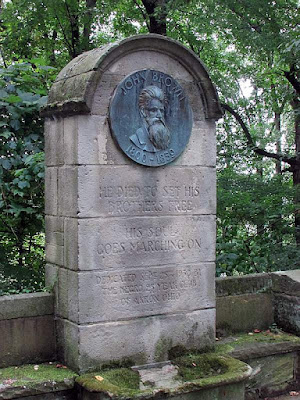Ever take a walk in the woods, and a monument appears? We were walking, in a group of almost twenty, in part of the former lands of Simon Perkins. His father, Simon (whose father also was a Simon Perkins) was a surveyor for Moses Cleaveland. Those two Simons were among the largest owners of land in the Connecticut Western Reserve, and then Ohio. The middle Simon was the co-founder of Akron. His son moved to Akron to manage part of those lands. He had many sheep, and went into business with John Brown. To-day, some of that land is Akron Zoo, and Perkins Park.
John Brown had a home in Akron Ohio from 1844 to 1854. Ohio was a free state then, and he came from Connecticut Yankee stock. In 1837, Brown was living in nearby Hudson. In church, John made a public declaration that he consecrated his life to he abolition of slavery. In Akron, he became a sheepman and wool merchant. In his business travels, he was a conductor of the Underground Railroad—he led enslaved people north to freedom. He was called Captain John Brown.
Brown was hanged in December 1859. Historically, he was Akron's most significant resident. It was approaching fifty years, and there was no monument in Akron of Brown. Akron's German American Alliance acquired a sandstone column from the demolished county courthouse, placed it on a plinth, and put a metal eagle (gone for some time) on top in 1910. In 1938, a plaza, seating and a second monument was added.
John Brown 1800-1859
He died to set his brothers free
His soul goes marching on
Dedicated Sept 25ᵗʰ 1938 by the Negro 25 Year Club of Akron Ohio
 |
| medallion close up [foto:jz] |
John Brown is an important historical figure. His cause was just, and he became
willing to use violence, combat, and bloodshed. He, and some of his sons were involved in Bleeding Kansas, in the second half of the 1850s. A precursor to the later war, that involved all of the United States, was fought in Kansas on the issue of chattel slavery. There was a federal armory in Harpers Ferry Virginia with 10,000 muskets and rifles. He and a group of men, the size of the group who visited the monument to-day, went to capture the armory in October 1859. He planned to arm the enslaved in Virginia. Rebellion, insurrection, uprising, and freedom were to come to county, after county in Virginia, and the rest of the South. He failed.
For decades, the slave owners had been paranoid, and fearful of slave revolts. Now, white men, Yankees were willing to start revolts. Brown terrified them, and his actions would be called terrorism to-day. To many in the North, and to Black Americans he was a hero, and martyr. To many on both sides, he was the other bookend to Abraham Lincoln.
Recently, Confederate monuments have been removed. Modern sympathisers were upset. For those, who would know of the existence of the John Brown memorials, they would not be pleased with their continued existence.
________________________
postscriptum: There are southerners still who say, "Well, i'll be John Browned". John Browned is a synonym for damned, and hanged.




No comments:
Post a Comment